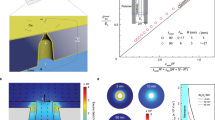Abstract
Motion control of a single molecule through a solid-state nanopore offers a new perspective on detecting and analyzing single biomolecules. Repeat recapture of a single DNA molecule reveals the dynamics in DNA translocation through a nanopore and may significantly increase the signal-to-noise ratio for DNA base distinguishing. However, the transient current at the moment of voltage reversal prevents the observation of instantly recaptured molecules and invalidates the continuous DNA ping-pong control. We performed and analyzed the DNA translocation and recapture experiment in a silicon nitride solid-state nanopore. Numerical calculation of molecular motion clearly shows the recapture dynamics with different delay times. The prohibited time when the data acquisition system is saturated by the transient current is derived by equivalent circuit analysis and finite element simulation. The COMSOL simulation reveals that the membrane capacitance plays an important role in determining the electric field distribution during the charging process. As a result of the transient charging process, a non-constant driving force pulls the DNA back to nanopores faster than theoretically predicted. The observed long time constant in the transient current trace is explained by the dielectric absorption of the membrane capacitor.





Similar content being viewed by others
References
Branton D, Deamer DW, Marziali A et al (2008) The potential and challenges of nanopore sequencing. Nat Biotechnol 26:1146–1153
Clarke J, Wu HC, Jayasinghe L et al (2009) Continuous base identification for single-molecule nanopore DNA sequencing. Nat Nanotechnol 4:265–270
Derrington IM, Butler TZ, Collins MD et al (2010) Nanopore DNA sequencing with mspa. Proc Natl Acad Sci USA 107:16060–16065
Li J, Stein D, McMullan C et al (2001) Ion-beam sculpting at nanometre length scales. Nature 412:166–169
Yanagi I, Akahori R, Hatano T et al (2014) Fabricating nanopores with diameters of sub-1 nm to 3 nm using multilevel pulse-voltage injection. Sci Rep 4:5000
Merchant CA, Healy K, Wanunu M et al (2010) DNA translocation through graphene nanopores. Nano Lett 10:2915–2921
Schneider GF, Kowalczyk SW, Calado VE et al (2010) DNA translocation through graphene nanopores. Nano Lett 10:3163–3167
Garaj S, Liu S, Golovchenko JA et al (2013) Molecule-hugging graphene nanopores. Proc Natl Acad Sci USA 110:12192–12196
Liu S, Lu B, Zhao Q et al (2013) Boron nitride nanopores: highly sensitive DNA single-molecule detectors. Adv Mater 25:4549–4554
Zhou Z, Hu Y, Wang H et al (2013) DNA translocation through hydrophilic nanopore in hexagonal boron nitride. Sci Rep 3:3287
Liu K, Feng J, Kis A et al (2014) Atomically thin molybdenum disulfide nanopores with high sensitivity for DNA translocation. ACS Nano 8:2504–2511
Kim MJ, McNally B, Murata K et al (2007) Characteristics of solid-state nanometre pores fabricated using a transmission electron microscope. Nanotechnology 18:205302
Squires AH, Hersey JS, Grinstaff MW et al (2013) A nanopore–nanofiber mesh biosensor to control DNA translocation. J Am Chem Soc 135:16304–16307
Peng HB, Ling XS (2009) Reverse DNA translocation through a solid-state nanopore by magnetic tweezers. Nanotechnology 20:185101
Hyun C, Kaur H, Rollings R et al (2013) Threading immobilized DNA molecules through a solid-state nanopore at >100 μs per base rate. ACS Nano 7:5892–5900
Zhang HB, Zhao Q, Tang ZP et al (2013) Slowing down DNA translocation through solid-state nanopores by pressure. Small 9:4112–4117
Gershow M, Golovchenko JA (2007) Recapturing and trapping single molecules with a solid-state nanopore. Nat Nanotechnol 2:775–779
Plesa C, Cornelissen L, Tuijtel MW et al (2013) Non-equilibrium folding of individual DNA molecules recaptured up to 1000 times in a solid state nanopore. Nanotechnology 24:475101
Sen YH, Jain T, Aguilar CA et al (2012) Enhanced discrimination of DNA molecules in nanofluidic channels through multiple measurements. Lab Chip 12:1094–1101
Dimitrov V, Mirsaidov U, Wang D et al (2010) Nanopores in solid-state membranes engineered for single molecule detection. Nanotechnology 21:065502
Ling DY, Ling XS (2013) On the distribution of DNA translocation times in solid-state nanopores: an analysis using schrodinger’s first-passage-time theory. J Phys Condens Matter 25:375102
Robertson RM, Laib S, Smith DE (2006) Diffusion of isolated DNA molecules: dependence on length and topology. Proc Natl Acad Sci USA 103:7310–7314
Carminati M, Ferrari G, Ivanov AP et al (2013) Design and characterization of a current sensing platform for silicon-based nanopores with integrated tunneling nanoelectrodes. Analog Integr Circuits Process 77:333–343
Kowalczyk SW, Grosberg AY, Rabin Y et al (2011) Modeling the conductance and DNA blockade of solid-state nanopores. Nanotechnology 22:315101
Acknowledgments
This work was supported by the National Basic Research Program of China (2012CB933002) and Strategic Priority Research Program (B) of the Chinese Academy of Sciences (XDB07030100). X. Shan acknowledges the financial aid from Open Research Fund Program of the State Key Laboratory of Low-Dimensional Quantum Physics (KF201201) and X. Lu thanks the support of Hundred Talent Program of Chinese Academy of Sciences.
Conflict of interest
The authors declare that they have no conflict of interest.
Author information
Authors and Affiliations
Corresponding author
Additional information
SPECIAL TOPIC: Nanopore Analysis
About this article
Cite this article
Hu, Y., Zhou, Z., Shan, X. et al. Detection and analysis of DNA recapture through a solid-state nanopore. Chin. Sci. Bull. 59, 4953–4959 (2014). https://doi.org/10.1007/s11434-014-0662-2
Received:
Accepted:
Published:
Issue Date:
DOI: https://doi.org/10.1007/s11434-014-0662-2




